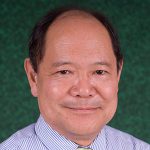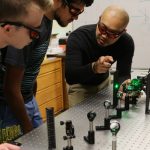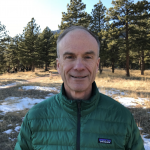
With the recent successful results of the T2K collaboration, we asked Professor Walter Toki to share the story behind his work on the T2K experiment, as well as reflect on his broader career.
When and why did you start working on T2K project? What sparked your interest?
After finishing my work on the BaBar experiment in which the collaboration observed CP violation in B meson oscillations, I participated in writing a proposal to build a neutrino detector in the Henderson mine with Professor Bob Wilson. During this time, I started looking into joining a new experiment. In 2006, the T2K experiment in Japan was recently approved. This experiment sought to search for muon type neutrino oscillations into electron type neutrinos, . After working with grad students Adam Pearlstein and Michael Gordon on a study of neutrino oscillation physics, it was clear that this was a very important fundamental measurement. However, at that time, there were upper limits from previous experimental searches and I expected in the T2K experiment we would spend years setting an upper limit. Fortunately, this was not the case.
What’s been the biggest challenge with this project? And the biggest reward?
The biggest challenge was building the US P0D detector parts at CSU and assembling the P0D detectors at Stony Brook University during my sabbatical. The CSU group took a major part in the design, by Dave Warner, and the construction of the P0D detector parts at CSU, where Bob Wilson, Norm Buchanan and Bruce Berger led important construction projects. Our work was funded by DOE and it was completed within budget and on schedule.
The biggest reward was that the detectors worked as designed and the T2K experiment observed this new oscillation of about a year before the tragic 2011 Tohoku earthquake in Japan. During data taking, before the earthquake, it was an extraordinary time when every few weeks at a T2K phone conference call, a new event candidate would be presented as more data was accumulated and everyone in the T2K collaboration began to realize that a major discovery was unfolding.
What do you see emerging in the next 5 and 10 years of the research?
In the next five years, the T2K experiment has a modest upgrade and in the next ten years, there are major new neutrino projects that are starting up. This includes the Hyper-K experiment, which recently has been approved by the Japanese Diet and the US DUNE project. Both propose to do a precision neutrino and antineutrino oscillation measurements to test CP violation.
Tells us more about the recent T2K discoveries?
After the discovery of oscillations, the T2K experiment made a number of engineering measurements of neutrino cross sections, improved the precision of the
oscillation measurements and very recently T2K completed important measurements of both neutrino and antineutrino oscillations where probabilities, P(
) is observed to be greater than
by a 3 standard deviation significance. This measurement indicates that CP is violated in neutrino oscillations. This is now being published in NATURE in April 2020.
Please share some general reflections on your work over the past decade.
Since coming to CSU in 1992, I have been involved in a precision Tau mass measurement, CP violation measurement in neutral B meson oscillations, nu->ne oscillations and now evidence for CPV violation in neutrino oscillations. When I was a graduate student at MIT in 1974, I participated in the set up and first run of an experiment at Brookhaven National Labs that discovered the J/psi particle in proton-proton collisions. This discovery was perhaps the most important particle physics discovery over a 10-20 year period, comparable in importance to the Higgs boson discovery in 2012. The J/psi discovery led to the evidence of the charm quark and started the beginning of the 6 quark/antiquark and 6 lepton/antilepton Standard Model whose final validation was the observation of the Higgs boson. I would judge the B meson and neutrino oscillation measurements to be the most important over a period of 5 years. When I look back, participation in these experiments and measurements has been very satisfying.


